The Chernarussian Civil War (2009), better known as the September Crisis, was a conflict that took place in the Green Sea nation of Chernarus. It was fought between Western-backed Chernarussian government forces and pro-Russian separatists.
Background[]
Following the collapse of the Soviet Union in 1991, Chernarus, then-known as the Chernarussian Soviet Socialist Republic (or C.S.S.R for short), was amongst one of the many ex-Soviet territories to regain its independence.
Though the majority of the free republic supported the new government in Novigrad to become an independent country, a minority in the northern regions began to form and remained discontent, favouring integration with the Russian Federation instead.
While vocal, these voices of discontent were drowned out by the majority of Chernarussians who wanted nothing to do with the Union's successor, and sought closer integration with the West; particularly with the United States and its NATO allies.
However, pro-Russian citizens remained adamant and in 1999, would unite to form an opposition party as the so-called "Chernarussian Movement of the Red Star" (ChDKZ). The ChDKZ and its supporters vowed to challenge the ruling pro-West New Deal Party; their ultimate goal being full integration with Russia.
Reception from Chernarussians elsewhere in the country was cold at best and borderline hostile at worst. In response to its rise, anti-ChDKZ radicals rallied together to form the "National Party" (NAPA), vowing to stamp out the ChDKZ and its pro-Russian supporters.
Skirmishes between supporters on both sides would gradually escalate into bloody violence, though the government did very little to stop the fighting and one-sidedly downplayed NAPA's actions.
By 2007, the ChDKZ was outlawed and deemed illegitimate by a majority vote, losing its status and for its supporters, a voice in the government. Outraged, the ChDKZ viewed this act as nothing short of an attempt to suppress its existence; a view reinforced no less by Novigrad's refusal to condemn NAPA.
Early battles[]
The decree banning the ChDKZ resulted in mass anti-government demonstrations taking place all across the northern regions. Many of these were concentrated in South Zagoria which bordered the Russian Federation and consisted heavily of dual nationals with both Russian and Chernarussian heritage.
The protests were quickly suppressed by both government and local security forces, though several turned violent and resulted in deaths. Animosity towards the government was further fuelled by NAPA fighters looting and burning down establishments with known ties to the ChDKZ. The worst of the violence reached its peak by late 2008, forcing the ChDKZ and its leaders to go into hiding.
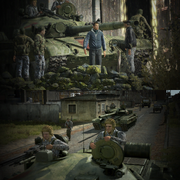
The ChDKZ rallies its supporters for war.
In reality, the ChDKZ was preparing to stage a full-scale uprising throughout South Zagoria. If they were successful, they could announce their declaration of intent to integrate the province into the Russian Federation.
In turn, the Russian military would be deployed into South Zagoria to safeguard the region's security, and prevent Novigrad from reclaiming the province.
First ChDKZ uprising[]
On July 27th, 2009, the ChDKZ staged its first major uprising across South Zagoria. Suddenly, government forces found themselves under siege by ChDKZ supporters and many officials were attacked while en-route to their destinations.
The uprisings were largely fruitless, however. Uncoordinated and directed by militarily-inept leaders, the short-lived uprising was swiftly crushed by security forces with the help of the military. Many ChDKZ fighters were killed and their supporters arrested, once again forcing the organisation's leaders to go into hiding.
ChDKZ resurgence[]
Unbeknownst to the Chernarussian government, the leaders of the ChDKZ were secretly in talks with an operative from the Russian Spetsnaz. Known only by his codename "Karelin", he represented a wider group of Russian military officials and politicians who were sympathetic to the plight of the ChDKZ, and offered to provide tactical leadership and financial aid.

The ChDKZ solidifies its hold over the entire eastern region, with only small pockets of government troops holding out.
The ChDKZ leader, Gregori Lopotev and his second-in-command, Mikola Bardak, accepted the operative's offer. Over the next two months, the ChDKZ continued to bide its time and stockpiled weapons and equipment, provided to them by Aslan Radayev's band of arms smugglers based in nearby Bystrica.
In early September, the second uprising was initiated with the help of Karelin's team of Spetsnaz operatives. With their covert assistance, the ChDKZ were successful in overrunning security forces and pushed back the (now-outgunned) military. Within a matter of weeks, most coastal cities and towns fell under ChDKZ control. Retreating elements of local police, CDF troops and militias, consolidated at a tiny pocket near the city of Zelenogorsk.
They spread their onslaught to other parts of the country with numerous ChDKZ sleeper cells activating in other regions. Not even outer islands such as the garrison on Utes were safe; the island fell in a matter of hours to the ChDKZ's relentless assault. The offensive continued and almost reaches the border with Takistan in the far west.

PM Baranov and leaders of the NDP are executed at Chernogorsk, rendering the government leaderless.
On October 3rd, ChDKZ fighters with the help of local supporters managed to intercept the Prime Minister and many senior members of the NDP while on a visit to Chernogorsk, the regional capital of South Zagoria.
Broadcast live to the world (but specifically directed towards the Russian government), the ChDKZ leader announced that South Zagoria would be breaking away and reintegrating with Russia, declaring that the country would now be known as the "Chernarussian Socialistic Republic". Baranov and the NDP officials were subsequently executed on live television.
Later stages[]
The ChDKZ's claim was immediately rejected by the Kremlin, though Russian leaders refused to outright condemn the group's action. Nevertheless, in response to PM Baranov's death, the Russian government called for an emergency session at the UN Security Council in an attempt to formulate a solution to the crisis.
The first session ended in a bitter deadlock when representatives from the United States refused to accept a Russian proposal to have its forces maintain a ceasefire between the warring factions.
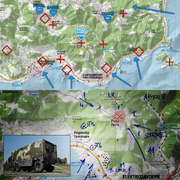
The 27th MEU's plan of attack on South Zagoria.
Matters were further complicated when it was revealed that the (leaderless) Chernarussian government-in-exile was secretly negotiating to have an American-led task force help retake the renegade province.
Furthermore, the U.S. Marine Corps' 27th Marine Expeditionary Unit (27th MEU) was already staging its forces in nearby Grozovia and off the coast of South Zagoria.
Operation Harvest Red[]
- Main article: Harvest Red
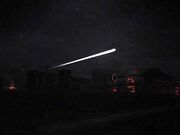
Anti-aircraft tracer fire lights the skies above Chernogorsk overnight.
Against the vociferous objections of the Russian government, the 27th MEU commenced its full-scale invasion of the entire province and attacked coastal cities in the early hours of October 9th.
Cruise missiles and fighter aircraft were spotted bombarding ChDKZ positions all along the coast while ground troops - supported by remnants of the Chernarussian military, lay siege to the regional capital by dawn. Within 24 hours, all of South Zagoria's coastal settlements were firmly under government control once more.
Remnants of the ChDKZ's forces retreated while units advancing westward were pulled back to assist fighters on the eastern front. Bolstered by American support however, Chernarussian government forces continued their push north towards known ChDKZ strongholds in Krasnostav and other remote settlements near the Black Mountains.

U.S. Marines push into the regional capital alongside remnants of the CDF's 8th Battalion.
NAPA supporters, urged on by their shadowy leader, were rising up in many of the towns close to the front and began to overthrow their ChDKZ oppressors without help from either the Americans or the government. Some were unsuccessful and were quickly crushed by the ChDKZ, though many were able to retake their settlements.
Fighters often took the opportunity to loot and execute pro-ChDKZ supporters. Chernarussians with Russian heritage were especially targeted and harassed; in some cases, even lynched in public executions.
Moscow bombings[]
An interim government was re-established in Novigrad and was chaired by Foreign Minister Dočasný, with Chief Cabinet Secretary Jan Haládik also serving a prominent role in the new government. For the 27th MEU, their mission now transitioned from invasion to counterinsurgency, with several units assisting government forces in patrolling the northern countryside for activity from both the ChDKZ and NAPA.
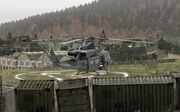
FOB Manhattan, a bitter point of contention between U.S. and Russian officials over its close proximity to the Russian border.
Meanwhile, a second session at the UN Security Council was convened following the U.S.-led intervention to discuss the growing humanitarian crisis. However, Russian officials continued to maintain that they would not accept any proposal that did not include the unilateral withdrawal of all American forces.
While U.S. and Russian representatives continued to bicker at the UN over the handling of the crisis, the situation throughout the rest of the country was deteriorating rapidly. Mass rioting (some fomented by ChDKZ sleeper cells) in several major cities stretched security forces to breaking point.
With the majority of its troops committed to pushing the South Zagorian front, the military was unable to lend its assistance to quell the riots. Fuel shortages particularly exacerbated the situation, though little could be done to address the problems until all of South Zagoria was fully reclaimed.
For the ChDKZ, the government's unexpected wave of victories forced its leaders to resort to desperate measures. With backing from "Karelin", the insurgents secretly formulated a plan named "Operation Cobalt". The plan would involve setting off a bomb in the middle of Red Square in the heart of the Russian capital, Moscow. NAPA would be blamed for the terror attack and in response, the Russian government would attain the mandate it needed to eject the Americans while simultaneously giving it the opportunity to intervene.
On October 16th, the bombing was carried out and fifty three Russians are killed with almost two hundred more being mortally wounded. Russian representatives at the UN denounced the attack by NAPA, and blamed their U.S. counterparts for helping to spread terrorism to the region.
U.S. withdrawal and Russian intervention[]
Unable to refute the evidence which pointed to NAPA extremists carrying out the attack, the U.S. was forced to accept the Russian proposal which would see the entirety of the 27th MEU pulled out as a pre-condition. Within 48 hours, Russian peacekeepers from the 454th Guards Motor-Rifle Regiment would instead be assuming their place.

The CDF is forced to relinquish all of its gains in South Zagoria.
As per the agreement, a ceasefire would immediately take place with Russian troops maintaining the peace between both sides. However, the Chernarussian government would also be forced to withdraw to pre-Operation Harvest Red lines; essentially losing all reclaimed settlements to just Zelenogorsk, while the ChDKZ would take over territories that were lost from the American invasion.
CDF/NAPA counteroffensive[]
Despite having their hands tied from the Russian intervention, the Chernarussian government was covertly plotting to initiate a province-wide offensive aimed at retaking lost territories. The ChDKZ - still woefully undermanned from the invasion, would be unable to maintain their hold over the region.
At the same time, the U.S. government was holding closed door discussions with the Chernarussians that would see them permitted to redeploy onto Chernarussian soil. However, more hard evidence proving that their redeployment was justified was still needed before a case could be made in the Security Council. To that end, a USMC Force Reconnaissance team, callsigned Razor Team, would be "loaned" to the Chernarussians on the condition that their anonymity be maintained at all costs.
On October 18th, the CDF (with the help of Razor Team) carefully initiated their counteroffensive under the watchful eye of the 454th's peacekeepers. The towns of Pogorevka and Rogovo were top priority and after they were seized, the CDF established a forward operating base on their outskirts. Their next targets were Stary Sobor and Novy Sobor further north, but their heavily defended positions made it difficult to assault.
While preparing for their attack, moderates within NAPA were reaching out to the government and insisted that they bore no responsibility for the Moscow bombings. They did however, wish to form an alliance with the CDF. CDF officials were not as enthusiastic about the prospect of forming an alliance with a designated terror organisation, but were ultimately swayed out of the necessity given their strategic situation.
As a pre-condition, the current leader of the organisation - the extremist known only as "Prizrak", would have to be removed first. CDF officials were reluctant to stage an assassination attempt on NAPA's leader but relented when Razor Team's Marines volunteered to eliminate the leader. With Prizrak removed, the alliance between NAPA and the CDF was solidified and Stary Sobor/Novy Sobor were quickly retaken with their help.
Russian withdrawal and ChDKZ collapse[]
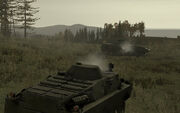
The CDF/NAPA offensive begins.
The second stage of the Chernarussian government's offensive could now begin.
The next day on October 19th, government forces slowly pushed their way east, overwhelming the weakened and understrength ChDKZ garrisons. Mounting evidence pointing to the ChDKZ - not NAPA - having carried out the Moscow bombings, was also being gathered by Razor Team.
In a surprising twist, the CDF were also able to intercept radio signals being transmitted from a hidden outpost on Skalisty Island in the region's south-east. Backed by statements from a ChDKZ fighter who wanted amnesty for his information, it was revealed that the elusive ChDKZ leader had been hiding on the island. Razor Team were able to infiltrate the island and capture the warlord before he could escape. He was subsequently brought back to Zelenogorsk via helicopter.
While Lopotev's capture was taking place, Novigrad was simultaneously in negotiations with the Kremlin to discuss the warlord's fate. In exchange for a complete Russian withdrawal, Lopotev would be personally handed over to the 454th's commander along with any evidence related to Operation Cobalt. Razor Team's Marines would be overseeing the handover as part of the agreement.
The handover is complicated when "Karelin" and his Spetsnaz team attack the site in an apparent attempt to rescue Lopotev. But their attack fails and "Karelin" is killed, with his identity being verified by a surviving Russian officer at the scene. Meanwhile, the 454th's commander was able to flee with Lopotev intact. He was quickly brought back to the Russian airbase at Vybor and his testimony absolves NAPA of any involvement in the bombings.
The 454th's peacekeeping mandate is soon revoked by unanimous vote at the Security Council, and the 27th MEU is granted the authority to redeploy into South Zagoria. After government forces were able to seize Chernogorsk, Marine ground elements were flown in and brought ashore.
With the MEU's assistance, the CDF/NAPA swept through the remaining north-eastern settlements and were able to locate the main ChDKZ base hidden at the village of Msta. Following a fierce battle that lasted for an hour, the bulk of the ChDKZ's forces were routed. Remnants of the main force and small cells continued to defiantly hold out for several more days, but they would all fall by the end of October 22nd.
Aftermath[]
Both the U.S. and Russian government quietly agreed to maintain total silence. Rumours of Russian soldiers coming into conflict with their American counterparts were quashed and denied by both sides.
For the families of deceased servicemen, their deaths were explained to have been caused by the "mistakes" of low-level commanders and "border incidents" that were peacefully resolved. Likewise, reports of U.S. and Russian special operations being involved throughout the crisis were suppressed and remain classified at the highest levels.
One of the masterminds of the war, former ChDKZ leader Gregori Lopotev, continues to remain under the custody of the Russian government. Following General Shagarov's revelations, a massive internal shakeup has also taken place within the highest echelons of the Russian military. Several military officials and politicians have been implicated with helping to further the conspiracy, were tried, and subsequently sentenced to death for committing high treason.
The National Party, now led by moderates, have disbanded as a paramilitary organisation and formally holds a position within the Chernarussian government. Their incumbent leader, Valery Michalkov, has announced that his party intends to challenge the NDP for the office of the Prime Minister.
To address the growing humanitarian crisis, a task force consisting of both British and Czech forces will be deploying to the troubled regions to assist in reconstruction efforts and delivering humanitarian aid. Their deployment lasted until mid 2012.
Legacy[]
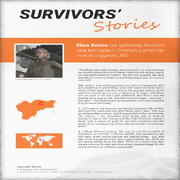
Klara Kozlov, a South Zagorian villager, is but one of the many Chernarussians who continue to face hardship two decades after the war's resolution.
Two decades on, the effects of the civil war continue to linger long after its cessation. Every year, untold numbers of South Zagorian villagers are maimed from setting off Unexploded Ordnance (UXO) fragments and anti-personnel landmines left over from the conflict.
Non-Government Organisations and Chernarussian authorities work tirelessly to disarm these devices. However, given the size of the forests surrounding the Black Mountains and difficulty in accessing many of the sites, it could take decades - if not a century, to fully demine the region.
Dual nationals are still viewed with suspicion and remain ostracised by the rest of the country. Former ChDKZ supporters are often targets of harassment and many have opted to leave Chernarus in order to start a new life elsewhere (usually in the Russian Federation).
Trivia[]
- The conflict appears to have been heavily inspired by the real-world 2008 South Ossetian war between Russia and the Republic of Georgia.
- As a former Soviet territory, Georgia also faced dissent within its population with a pro-Russian minority in the leadup to the conflict. Eventually, this minority broke away from the country, and the territory was (illegally) occupied and annexed by the Russian government.
- On the other hand, inspiration for the ethnic tensions between the various Chernarussian groups seems to be drawn from the Yugoslav Wars of the early 1990s-2001. The conflicts that followed in the aftermath of the breakup of Yugoslavia; not least the war crimes committed by all sides involved, parallels the extremism of both NAPA and the ChDKZ.
See also[]
| Armaverse conflicts | |
|---|---|
| 1980s | Soviet occupation of Nogova (1982) • Malden Islands Crisis (1985) • Takistan Civil War (1988-1992) |
| 2000s | Sahrani Conflict (2006) • Chernarussian Civil War (2009) |
| 2010s | Operation Arrowhead (2012) • Operation Crimson Lance (2012) |
| 2020s | Altian Civil War (2026-2030) |
| 2030s | Altis Incident (2035) |
| NOTE: Conflicts fought in spin-off titles, non-canon expansions/DLCs, lone skirmishes between isolated groups or conflicts without significant details are deliberately excluded. | |
